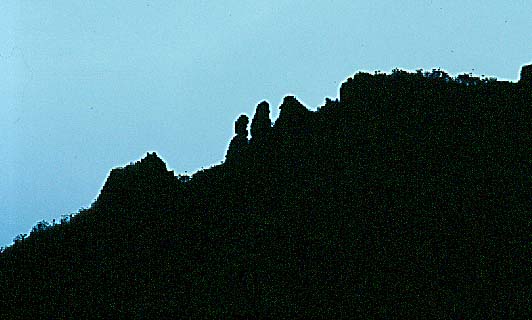 |
 |
 |
|||||
|
|
|
|
|
|
|
|
|
|
|
|||||||
|
|
The Piliwale Sisters turned to stone as they fled down the ridge.
|
The Piliwale Sisters Frederick Wichman tells the story of the Piliwale sisters: "Na-piliwale, "clinging ones," a stone formation on the Manoa ridge, looks like two running figures with their skirts flying up behind them. It was the custom of the four Piliwale sisters to visit a chief's court and remain until all the food in the area had been consumed. Therefore, their appearance heralded a forthcoming famine. They had prodigious appetites and their favorite foods were the freshwater shrimp, the wi, freshwater snails, and the fiddlehead of the fern ho‘i‘o. Two of these sisters came to Ha‘ena for a visit. Because they were kupua and could not tolerate the sun, Lohi'au and his sister Kahua built them a shelter in Maniniholo Cave and another on the ridge where they could enjoy the view. They were fed their favorite foods all through the night and were entertained by every hula dancer of the school at Ke‘e. As the night winds grew chill, Kahua ordered the sides of the shed enclosed with mats. The sisters so enjoyed themselves that they forgot the time. Then at dawn Kahua drew aside the wall coverings and the sisters, with cries of dismay, raced down the ridge to the cave. The sun's rays caught them as they ran and they turned to stone. They remain there as a warning to the other two sisters not to visit Kaua‘i."
|
||
|
|
||
Other Storied Places There are many stories from within Ha‘ena that have been captured by Frederick Wichman, Chipper's uncle. You can read these and more Kaua‘i place-name stories in his book, "Kaua‘i: Ancient Place Names and Their Stories" (Honolulu: University of Hawai'i press, 1998). Here are two more of his tales from Ha‘ena. "Ke-a‘a-lewalewa, "dangling root," is a peak on the east side of Manoa Valley. A‘a lewalewa are the aerial roots of the ‘ohi‘a lehua tree of the forests or the pandanus tree of the lowlands. Kea‘alewalewa was a Wainiha man who constantly stole food from the Menehune farmers in Manoa Valley. They got so angry after a time that they chased after him and turned him to stone. The name conveys the connotation of "dangling," and thus indicates that he was doing more than stealing food. "Another Hawaiian man and his wife used to steal from the fields of the Menehune farmers in Manoa Valley. The Menehune finally chased after the two with intent to get rid of them once and for all. They chased the wife into Limahuli Valley. Near the waterfall, she had to stop for she was too tired to run farther. She was out of breath and sat gasping. The Menehune caught her there and killed her. She was turned to stone and is called Naenae, "congested." The man was chased up the ridge toward Pohaku-o-Kane. He was frightened, but he was very strong--as well as twice the size of the Menehune--and he put up a strong fight. The Menehune used their slingshots and pelted him with stones. Some of these were so large that the bones of his skull were shattered and stuck up through the scalp. In this form he turned to stone, and the ridge where he lies was named Ka-iwi-ku‘i, "hammered bone."
|
||
|
|
||
| |
| |
|
|
 |
| Ha'ena Home | Map Library | Site Map | Hawaiian Islands Home | Pacific Worlds Home |

|
|||
| Copyright 2001 Pacific Worlds & Associates • Usage Policy • Webmaster |
|||




